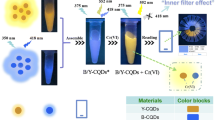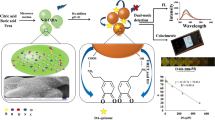Abstract
A smartphone-assisted fluorescence color sensing system for rapid, convenient, and on-site detection of copper ions was developed. The ratiometric fluorescence sensor was fabricated by using silica-coated blue-light-emitting carbon dots and surface-grafted red-light-emitting cadmium-telluride quantum dots. After exposure to Cu2+ in 20 s, the red fluorescence was quenched obviously, while the blue fluorescence remained unchanged, and the sensor color changes continuously from red to blue under the ultraviolet lamp. The concentration (50–1200 nM) of copper ions could be measured by the fluorescence spectrum (excitation at 360 nm, dual-emission at 441 and 640 nm) with a detection limit of 7.7 nM. The fluorescence colors were converted to digital RGB values to calculate the concentration of copper ions by a smartphone with a detection limit of 9.6 nM. The method was applied to detecting copper ions spiked in real samples with recovery from 97.9 to 108.0% and RSD from 3.8 to 8.9%. Thus, this convenient and practical fluorescence color sensing system presents a new strategy for rapid, sensitive, and on-site determination of copper ions in environmental or biological samples.
Graphical abstract







Similar content being viewed by others
References
Ozkantar N, Yilmaz E, Soylak M, Tuzen M (2020) Pyrocatechol violet impregnated magnetic graphene oxide for magnetic solid phase microextraction of copper in water, black tea and diet supplements. Food Chem 321:126737
Zhu S, Asim Khan M, Wang F, Bano Z, Xia M (2020) Rapid removal of toxic metals cu2+ and pb2+ by amino trimethylene phosphonic acid intercalated layered double hydroxide: a combined experimental and dft study. Chem Eng J 392:123711
Maxwell TJ, Rajasekaran P, Das S, Campos MGN, Young M, Mendis HC, Ozcan A, Gerberich KM, Myers ME, Graham JH, Johnson EG, Santra S (2019) Control of citrus canker in greenhouse and field with a zinc, urea, and peroxide ternary solution. J Agric Food Chem 67(45):12393–12401
Murugan N, Prakash M, Jayakumar M, Sundaramurthy A, Sundramoorthy AK (2019) Green synthesis of fluorescent carbon quantum dots from eleusine coracana and their application as a fluorescence ‘turn-off’ sensor probe for selective detection of cu2+. Appl Surf Sci 476:468–480
Guo Z, Niu Q, Li T, Sun T, Chi H (2019) A fast, highly selective and sensitive colorimetric and fluorescent sensor for cu(2+) and its application in real water and food samples. Spectrochim Acta A Mol Biomol Spectrosc 213:97–103
Liu M, Wang K, Wang H, Lu J, Xu S, Zhao L, Wang X, Du J (2021) Simple and sensitive colorimetric sensors for the selective detection of cu(ii). RSC Adv 11(19):11732–11738
Gu J, Donati GL, Young CG, Jones BT (2011) Continuum source tungsten coil atomic fluorescence spectrometry. Appl Spectrosc 65(4):382–385
Zeiner M, Cindric IJ, Kroeppl M, Stingeder G (2010) Determination of copper in clarified apple juices. J Agric Food Chem 58(6):3617–3620
Su P-G, Lin L-G, Lin P-H (2014) Detection of cu(ii) ion by an electrochemical sensor made of 5,17-bis(4 ’-nitrophenylazo)-25,26,27,28-tetrahydroxycalix 4 arene-electromodified electrode. Sensors Actuators B Chem 191:364–370
Zhong Y, Xue F, Wei P, Li R, Cao C, Yi T (2018) Water-soluble mos2 quantum dots for facile and sensitive fluorescence sensing of alkaline phosphatase activity in serum and live cells based on the inner filter effect. Nanoscale 10(45):21298–21306
Zhang Q, Sun Y, Liu M, Liu Y (2020) Selective detection of fe3+ ions based on fluorescence mxene quantum dots via a mechanism integrating electron transfer and inner filter effect. Nanoscale 12(3):1826–1832
Li X, Wang Y, Fu Q, Wang Y, Ma D, Zhou B, Zhou J (2020) Plasmon-emitter hybrid nanostructures of gold nanorod-quantum dots with regulated energy transfer as a universal nano-sensor for one-step biomarker detection. Nanomaterials 10(3):444
Gong W, Li H, Gong X, Zhang Z, Lu Z (2020) Fabrication of amine functionalized CdSe@Sio2 nanoparticles as fluorescence nanosensor for highly selective and sensitive detection of picric acid. Spectrochim Acta A Mol Biomol Spectrosc 233:118221
Wang B, Tan H, Zhang T, Duan W, Zhu Y (2019) Hydrothermal synthesis of n-doped carbon dots from an ethanolamine-ionic liquid gel to construct label-free multifunctional fluorescent probes for hg(2+), cu(2+) and s2o3(2). Analyst 144(9):3013–3022
Wang H, Lu Q, Li M, Li H, Liu Y, Li H, Zhang Y, Yao S (2018) Electrochemically prepared oxygen and sulfur co-doped graphitic carbon nitride quantum dots for fluorescence determination of copper and silver ions and biothiols. Anal Chim Acta 1027:121–129
Jiao M, Li Y, Jia Y, Yang Z, Luo X (2019) Aqueously synthesized color-tunable quaternary cu-in-zn-s quantum dots for cu(ii) detection via mild and rapid cation exchange. Sensors Actuators B Chem 294:32–39
Sang F, Zhang X, Shen F (2019) Fluorescent methionine-capped gold nanoclusters for ultra-sensitive determination of copper(ii) and cobalt(ii), and their use in a test strip. Mikrochim Acta 186(6):373
Yao J, Zhang K, Zhu H, Ma F, Sun M, Yu H, Sun J, Wang S (2013) Efficient ratiometric fluorescence probe based on dual-emission quantum dots hybrid for on-site determination of copper ions. Anal Chem 85(13):6461–6468
Lu H, Quan S, Xu S (2017) Highly sensitive ratiometric fluorescent sensor for trinitrotoluene based on the inner filter effect between gold nanoparticles and fluorescent nanoparticles. J Agric Food Chem 65(44):9807–9814
He K, Zhan X, Liu L, Ruan X, Wu Y (2020) Ratiometric fluorescent paper-based sensor based on cdte quantum dots and graphite carbon nitride hybrid for visual and rapid determination of cu(2+) in drinks. Photochem Photobiol 96(5):1154–1160
Babaee E, Barati A, Gholivand MB, Taherpour AA, Zolfaghar N, Shamsipur M (2019) Determination of hg(2+) and cu(2+) ions by dual-emissive ag/au nanocluster/carbon dots nanohybrids: switching the selectivity by ph adjustment. J Hazard Mater 367:437–446
Liu ZC, Qi JW, Hu C, Zhang L, Song W, Liang RP, Qiu JD (2015) Cu nanoclusters-based ratiometric fluorescence probe for ratiometric and visualization detection of copper ions. Anal Chim Acta 895:95–103
Rao H, Liu W, Lu Z, Wang Y, Ge H, Zou P, Wang X, He H, Zeng X, Wang Y (2015) Silica-coated carbon dots conjugated to cdte quantum dots: a ratiometric fluorescent probe for copper(ii). Microchim Acta 183(2):581–588
Chen L, Tian X, Yang C, Li Y, Zhou Z, Wang Y, Xiang F (2017) Highly selective and sensitive determination of copper ion based on a visual fluorescence method. Sensors Actuators B Chem 240:66–75
Wang H, Yang L, Chu S, Liu B, Zhang Q, Zou L, Yu S, Jiang C (2019) Semiquantitative visual detection of lead ions with a smartphone via a colorimetric paper-based analytical device. Anal Chem 91(14):9292–9299
Wang T, Mei Q, Tao Z, Wu H, Zhao M, Wang S, Liu Y (2020) A smartphone-integrated ratiometric fluorescence sensing platform for visual and quantitative point-of-care testing of tetracycline. Biosens Bioelectron 148:111791
Xie Y, Cheng D, Liu X, Han A (2019) Green hydrothermal synthesis of n-doped carbon dots from biomass highland barley for the detection of Hg2. Sensors (Basel) 19(14):3169
Khan WU, Wang D, Wang Y (2018) Highly green emissive nitrogen-doped carbon dots with excellent thermal stability for bioimaging and solid-state led. Inorg Chem 57(24):15229–15239
Xu M, He G, Li Z, He F, Gao F, Su Y, Zhang L, Yang Z, Zhang Y (2014) A green heterogeneous synthesis of n-doped carbon dots and their photoluminescence applications in solid and aqueous states. Nanoscale 6(17):10307–10315
Sun L, Zhang H, Wang Y, Xiong Z, Zhao X, Xia Y (2021) Chitosan-derived n-doped carbon dots for fluorescent determination of nitrite and bacteria imaging. Spectrochim Acta A Mol Biomol Spectrosc 251:119468
Shen M, Jia W, You Y, Hu Y, Li F, Tian S, Li J, Jin Y, Han D (2013) Luminescent properties of CdTe quantum dots synthesized using 3-mercaptopropionic acid reduction of tellurium dioxide directly. Nanoscale Res Lett 8:253
Li W, Zhang X, Hu X, Shi Y, Li Z, Huang X, Zhang W, Zhang D, Zou X, Shi J (2021) A smartphone-integrated ratiometric fluorescence sensor for visual detection of cadmium ions. J Hazard Mater 408:124872
Xie Y F, Jiang Y J, Zou H Y, Wang J, Huang C Z (2020) Discrimination of copper and silver ions based on the label-free quantum dots. Talanta 220:121430
Hao L, Shen Y, Chen X, Yang X, Du Q, Bian Y, Chen L, Tang K, Zhang R, Zheng Y, Gu S (2019) Different-sized cdte qds on the detection of cu2+ ions: combining experimental investigation with first-principles verification. Microchem J 148:684–690
Chen J, Chen H, Wang T, Li J, Wang J, Lu X (2019) Copper ion fluorescent probe based on zr-mofs composite material. Anal Chem 91(7):4331–4336
Funding
This work was financially supported by the Science and Technology Foundation of Hebei Agricultural University (no. LG201820), the Science Research Foundation of Hebei Agricultural University (no. ZD201720), and Basic Scientific Research Founding of Universities in Hebei Province (no. KY2021032). The authors would like to thank Shiyanjia lab for the support of XPS tests.
Author information
Authors and Affiliations
Corresponding author
Ethics declarations
Conflict of interest
The authors declare no competing interests.
Additional information
Publisher’s note
Springer Nature remains neutral with regard to jurisdictional claims in published maps and institutional affiliations.
Supplementary Information
Below is the link to the electronic supplementary material.
Rights and permissions
About this article
Cite this article
Wu, X., Meng, X., Hou, B. et al. Rapid fluorescent color analysis of copper ions on a smart phone via ratiometric fluorescence sensor. Microchim Acta 189, 67 (2022). https://doi.org/10.1007/s00604-022-05166-z
Received:
Accepted:
Published:
DOI: https://doi.org/10.1007/s00604-022-05166-z




